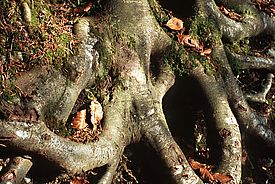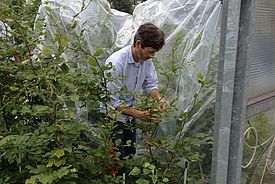18.07.2016 | News
Plants suffering from drought reduce the level of their form of 'food intake', photosynthesis, and therefore also their absorption of CO2. However, this reduction is not dictated solely by the leaves, as has previously been assumed, but primarily by the roots. This is the conclusion of a multi-annual experiment led by the Swiss Federal Institute for Forest, Snow and Landscape Research WSL.
Forests are regarded as a key sink for absorbing some of the greenhouse gas carbon dioxide (CO2) from the atmosphere. During the day, plants absorb carbon dioxide from the air and with the help of sunlight convert the carbon in the CO2 into sugar (carbohydrates), what is known as photosynthesis. When they consume this sugar for their vital functions they release a quantity of CO2 again. Growing trees retain some of the carbon contained by CO2, so in the long term absorb more of it than they release.
In a drought situation, plants' level of photosynthesis and therefore also of CO2 absorption decreases, but they continue to consume sugar. As a result, forests could lose their sink function and become a source of CO2 if dry phases become more common due to climate change. Therefore, up to now biologists assumed that when suffering from a water deficit, plants only absorb less carbon dioxide from the atmosphere because they close the stomata in their leaves to reduce water loss.
A team headed by WSL researchers Matthias Arend and Frank Hagedorn now reports in the renowned scientific journal "Nature Plants" that photosynthesis is also regulated from under the soil surface, namely by the roots. "With this finding we have changed the understanding of a fundamental biological process", says Arend.
Backlog of sugar in the plant
The team of researchers from Switzerland, Germany, Croatia and China found evidence for this in a unique model experiment. Over a number of years, they grew young trees in open-top glass chambers and then subjected them to a simulation of a summer drought before providing them with water again. Measurements during this period showed that in a drought the first parts of the plants to reduce their level of metabolic activity were the roots. Their sugar consumption fell and a backlog of unused carbohydrates built up in the plants. The researchers posit that the photosynthesis of the leaves was limited as a result of this. The conclusion given by Arthur Gessler, Leader of WSL's Forest Growth and Climate Group, is clear: "Roots regulate plants' carbon balance."
Remembering hard times
The surprises don't stop there though: as Arend reports, "In the trees we found a kind of 'ecological memory' of the drought." As soon as the levels of soil moisture were back to adequate levels, drought-experienced plants absorbed significantly more CO2 than control plants that had not experienced a drought under the same environmental conditions. "The plants, so to speak, 'stuff themselves' again after a starvation period", explains Gessler. The roots play a key role here too as they have an increased need for carbohydrates following the drought.
According to the researchers, this result indicates that the trees have an internal buffer mechanism that helps them to overcome the consequences of a period of drought. They point out that those wishing to evaluate shifts in forests' carbon balance over the course of climate change should consider these physiological processes.
Copyright
Copyright
WSL and SLF provide the artwork for imaging of press articles relating to this media release for free. Transferring and saving the images in image databases and saving of images by third parties is not allowed.
Contact
Links and documents
Original publication:
Hagedorn F, Joseph J, Peter M, Luster J, Pritsch K, Geppert U, Kerner R, Molinier V, Egli S, Schaub M, Liu J-F, Li M, Sever K, Weiler M, Siegwolf R, Gessler A, Arend M. 2016. Recovery of trees from drought depends on belowground sink control. Nature Plants, DOI: 10.1038/nplants.2016.111.

